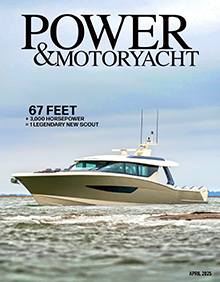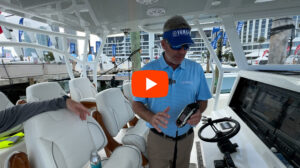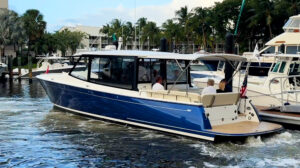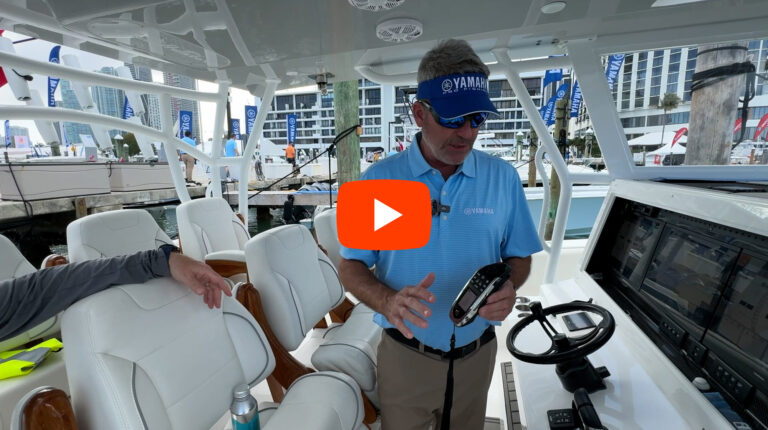The Golden Age of Radio?
Today’s VHF radios meet strict government standards but also add the functions and integration we’ve come to expect—and some that are delightfully unexpected.
As another boat show blooms on the beach in Miami, many boaters’ thoughts turn to updating the helm for next season. The eyes often come to rest on that tired old VHF. Now may be a great time to think about upgrading, as many of the developmental strides from the past five years have really come into their own.

What’s changed about VHF, you may ask? Marine radios today offer simplified integration and multiple functions contained in one housing. But because of the price point—usually from $150 to $400 compared with other marine electronics components—and strict regulations, manufacturers don’t normally pile on the features. For instance, up until now only Garmin offered quality VHF radios with a NMEA 2000 interface and only Standard Horizon offered a model with a built-in AIS receiver. The Simrad RS35 is first to combine these useful features.
“There have been a lot of NMEA 2000 devices over the last five years, but VHF has been quite slow to have NMEA 2000 integrated,” says Mark Harnett, regional sales manager and product manager for communications, safety, and AIS for Navico, parent company to Simrad (www.simrad-yachting.com) and Lowrance (www.lowrance.com), among others. “We heard from users trying to integrate their DSC radio into their chartplotter for the DSC functionality to work and for any DSC calls received to be plotted on the chartplotter.” Connecting the DSC radio to a GPS is required to get the full safety benefit of the system, yet end users have struggled with it—notably because there is no standard color for the wires that make the connection. NMEA 2000 is a protocol that uses a single standard connector to share data throughout the boat along a single backbone.
“We thought adding NMEA 2000 was going to make it much much easier for your average joe to connect DSC to his multifunction display,” Harnett says. “It’s just plug-and-play now—much simpler for connections.”

The Standard Horizon Matrix GX2150 AIS+ VHF ($399.95) has a built-in AIS receiver.
Some VHFs have a GPS built in. “The GPS are much more sensitive today so you can install the GX1700 Explorer GPS in an electronics box,” says Jason Kennedy, executive vice president of Standard Horizon (www.standardhorizon.com). “Even a few years ago, you had to use an external GPS antenna for chartplotters, today almost all chartplotters have an internal GPS antenna.” Kennedy said that radio, the Explorer GX1700 ($229), is being installed on boats ranging from runabouts to megayachts.
The other step to full DSC function is registering for a Marine Mobile Safety Identification number (MMSI). For boaters in U.S. waters, MMSI numbers are available for free from BoatUS.com or SeaTow.com. Simply program the number into a VHF connected to a GPS (international cruisers should get their MMSI from the FCC). The system does not work if you skip this step, yet many don’t do it. If you have a DSC-enabled VHF or are thinking about getting one, get an MMSI number.
Registering an MMSI number simplifies communication with commercial traffic and other boats at sea, and that’s where AIS comes in. Some manufacturers offer units with AIS receivers built in, while still others make it easy to connect a radio and AIS. The integration makes calling an AIS target from a VHF radio simple. And one day, boaters will be able to do the same from an integrated multifunction display—just hover the cursor over the target on the plotter to make the call.
Integration with the chartplotter will have some other benefits. “Soon you’ll be able to look at your DSC call log from your chartplotter,” Harnett says. “Using that big, bright LCD on your boat’s multifunction display to control more of your radio functionality directly. Especially so with a touchscreen.” This is akin to managing your e-mail on your laptop, though you read and write plenty of those messages on your smartphone.
A Little VHF Etiquette
There are any number of ways (books, pamphlets, the Internet, etc.) to get a handle on the rules and laws that govern VHF usage these days. But what about plain ol’ etiquette? You know—good manners? Aren’t there some subtleties to VHF usage that will promote solid communication as well as encourage bonhomie? Here are a few I’ve picked up on over the years.
In fact our reliance on smartphones has spoiled us. But radio manufacturers are taking that into account and improving usability.
“If a transmission comes in and you miss it, well now you have the ability, kind of like TiVo for VHF radios, where you can go play it back again,” says David McLain, national marine sales manager for Icom America (www.icomamerica.com). “So if you do miss it, you can go back and hear what they said.” The Icom M73 Plus will launch in Miami with a starting price of $299.99.
But if you can’t figure out how to use these features, they don’t do much good. Icom took that into account with its M424 and M92D radios, and the HM195 CommandMic IV. “All three of those units have our new user interface, which is four soft keys at the bottom and then cursor keys up top,” McLain says. “So it operates kind of like an iPod, which everyone knows how to use. Plus once you know how to use one unit [in the line], you know how to use them all because they all operate the same exact way.”
With all this functionality, radios have stayed the same size or gotten smaller. “Our RS35 is actually one of the larger radios out there,” Harnett says. “One of the advantages of a slightly larger radio is we can put a bigger speaker in it. We’ve got a 57-millimeter-diameter speaker, and it doesn’t necessarily make it too much louder, but it holds its audio quality higher up into the volume ranges so you’re not getting distortion at high levels. It’s deeper-sounding audio—it’s not so tinny.”
Icom focused on locating the radio function where the user expects it and perhaps foreshadowed further integration with the rest of the helm. Its black-box VHF, the M400BB, comes bundled with a CommandMicIV for $549.99. The black-box unit will be mounted out of sight, leaving just a jack on the helm to connect the mic.
As far as selecting a location for the VHF, Standard Horizon is simplifying the process by slimming down. “The GX1700 radio is only 3.5 inches from the knobs on the front to the heat sink at the back, and it swivels through the bracket,” Kennedy says. “So you can have an overhead mount, or you can mount it in any location on the helm, and it won’t bump into anything [behind it].”
Other strides in radio? There’s a wireless microphone with inductive charging: the Simrad HS35 ($169). Standard Horizon offers the handheld HX300 ($150), which can be charged from a USB port, thanks to a 3.75-volt battery. Or look at a higher-resolution LCD display, like that on the Simrad RS35 ($399), which has a screen that’s 180 by 128 pixels. What about two radios? Standard Horizon has a twin pack of HX100 handhelds with a two-station charger that retails for $150.
The bottom line is that ever-tightening regulations from the FCC and European governing bodies prevent drastic change. Meanwhile the expense of getting approval and the price point of products in the segment combine to create a challenging market environment.
“The first floating handheld radio was introduced about five years ago, and that was a big leap for VHF communciations,” Kennedy says. “Fixed-mount VHF radios have been slower to evolve: Thirteen years ago DSC was introduced. Over the past few years we have a integrated a GPS into a fixed-mount VHF radio to simplify installations and DSC—the Coast Guard commended us for that. And we’ve also introduced a VHF with an integrated AIS receiver. Today’s innovation leaps are smaller.”
This article originally appeared in the February 2013 issue of Power & Motoryacht magazine.







